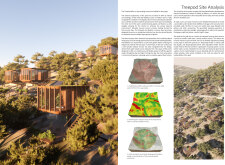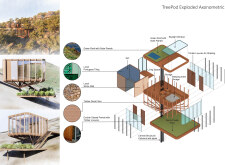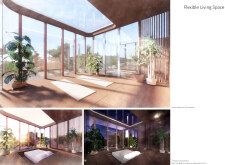5 key facts about this project
In terms of design, the TreePod incorporates a flexible layout that supports various activities. The internal configuration includes designated spaces for yoga, communal gatherings, and private retreats, allowing for adaptability based on group size and user preferences. The structure is oriented to maximize natural light and views, utilizing large double-glazed panels that contribute to energy efficiency and comfort. The integration of natural ventilation strategies—through movable timber louvres—ensures optimal air quality while reducing reliance on artificial climate control.
Sustainability is a defining characteristic of the TreePod project. The use of local timber not only supports the regional economy but also minimizes transportation emissions. The structure employs a green roof equipped with solar panels, which enhances energy efficiency and promotes ecological advantages. Moreover, local stone is selectively utilized within the interiors, reinforcing the connection between the architecture and the natural context. The project’s design also incorporates eco-conscious water management through rainwater harvesting systems.
An essential aspect that distinguishes the TreePod from similar architectural endeavors is its commitment to user experience. The interplay between indoor and outdoor spaces facilitates a direct engagement with nature, fostering a mindfulness practice that is integral to its intended use. The landscape surrounding the TreePod includes areas for gardening and relaxation, further enhancing the connection to the environment. Additionally, the adaptive nature of the interiors allows for varied programming possibilities, accommodating everything from individual yoga sessions to communal workshops.
For those interested in understanding this project more comprehensively, reviewing the architectural plans, sections, and designs will provide a deeper insight into the ideas underpinning the TreePod. Examine the unique elements that contribute to its functionality and aesthetic coherence, and explore how the overall design aligns with contemporary architectural practices.


























